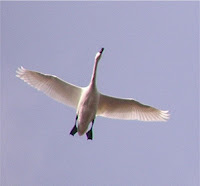TUNDRA SWAN
TUNDRA SWAN – (Cygnus columbianus) – (See images below)
DESCRIPTION: The Tundra Swan adult has white plumage with a black bill, black eyes, and black legs and feet. There is a small yellow patch at base of bill for the Whistling race (see note below), but this patch is larger in the Bewick’s race. Juvenile is light grey with white patches, bill is pink with black tip. This is a small swan at about 140 cm (55 inches).
VOICE: https://www.xeno-canto.org/species/Cygnus-columbianus
NAME: ‘Swan’ is from Anglo-Saxon and means the same. Latin genus name ‘Cygnus’ means ‘swan’, and Latin species name ‘columbianus’ derives from the area (Columbia River) where the first specimen was found.
HABITAT: Arctic tundra with bodies of water in the summer, along the coasts in winter, protected estuaries and bays, also agricultural fields.
DIET: Aquatic plants, some molluscs and crustaceans, leftover plants in fields. Feeds by upending in shallow water. When foraging in Chesapeake Bay for clams, their prey gets stolen right from their bills by gulls.
NESTING: It is believed that the species mates for life. Male helps build the nest, which is located near water. Around four or five creamy white eggs are laid, incubated by both parents. Young can feed themselves but cared for by both parents.
DISTRIBUTION: Breeds in the Arctic tundra of Russia, Alaska and Canada. Eurasian race winters in Japan and eastern China. North American race winters mainly along west coast of USA and a mid section of the USA east coast. Some rare individuals have reached far away places such as Hawaii.
Distribution Map: https://en.wikipedia.org/wiki/Tundra_swan#/media/File:Cygnus_columbianus_map.svg
ON PEI: Does not breed on Prince Edward Island, sightings listed as ‘accidental’ so far. See note below on bird vagrancy.
CONSERVATION: Population appears stable, currently not listed at risk. However potential threats include poisoning from lead ammunition, water pollution from mine waste, and habitat loss. There is a legal hunting season for this swan.
NOTES: There are two sub-species that sometimes are considered as conspecific – Eurasian race Bewick’s Swan (to honor bird engraver Thomas Bewick), and American race Whistling Swan (because of the sound the wings make when bird is flying).
These swans fly with their neck straight. They form flocks during migration and winter, and even when breeding they can be close.
Vagrancy: In biology this means an animal going way outside its normal range. For birds, this can happen when there are storms and they get blown off course. On other times, the bird simply wanders in a different direction than usual. Here’s an article about vagrancy in birds.
SIMILAR SPECIES: Trumpeter Swan (here’s an article on how to distinguish these two similar species), Snow Goose
REFERENCES: http://www.hww.ca/en/wildlife/birds/tundra-swan.html (Hinterland Who’s Who)
https://www.borealbirds.org/bird/tundra-swan
https://www.canadiangeographic.ca/article/animal-facts-tundra-swan
https://www.audubon.org/field-guide/bird/tundra-swan
https://www.tn.gov/twra/wildlife/birds/waterbirds/tundra-swan.html (Tennessee Wildlife Resources Agency)
http://www.oiseaux-birds.com/card-tundra-swan.html
https://nature.mdc.mo.gov/discover-nature/field-guide/trumpeter-swan (Missouri Department of Conservation)
https://animaldiversity.org/accounts/Cygnus_columbianus/ (University of Michigan)
https://en.wikipedia.org/wiki/Tundra_swan
http://www.ducks.org/hunting/waterfowl-id/tundra-swan
https://www.allaboutbirds.org/guide/Tundra_Swan
https://www.lambtonmuseums.ca/lambton-heritage-museum/annual-events/return-swans-festival-new/tundra-swan-migration/
https://birdatlas.mb.ca/accounts/speciesaccount.jsp?sp=TUSW&lang=en (Manitoba Breeding Bird Atlas)
http://identify.whatbird.com/obj/296/overview/Tundra_Swan.aspx
DESCRIPTION: The Tundra Swan adult has white plumage with a black bill, black eyes, and black legs and feet. There is a small yellow patch at base of bill for the Whistling race (see note below), but this patch is larger in the Bewick’s race. Juvenile is light grey with white patches, bill is pink with black tip. This is a small swan at about 140 cm (55 inches).
VOICE: https://www.xeno-canto.org/species/Cygnus-columbianus
NAME: ‘Swan’ is from Anglo-Saxon and means the same. Latin genus name ‘Cygnus’ means ‘swan’, and Latin species name ‘columbianus’ derives from the area (Columbia River) where the first specimen was found.
HABITAT: Arctic tundra with bodies of water in the summer, along the coasts in winter, protected estuaries and bays, also agricultural fields.
DIET: Aquatic plants, some molluscs and crustaceans, leftover plants in fields. Feeds by upending in shallow water. When foraging in Chesapeake Bay for clams, their prey gets stolen right from their bills by gulls.
NESTING: It is believed that the species mates for life. Male helps build the nest, which is located near water. Around four or five creamy white eggs are laid, incubated by both parents. Young can feed themselves but cared for by both parents.
DISTRIBUTION: Breeds in the Arctic tundra of Russia, Alaska and Canada. Eurasian race winters in Japan and eastern China. North American race winters mainly along west coast of USA and a mid section of the USA east coast. Some rare individuals have reached far away places such as Hawaii.
Distribution Map: https://en.wikipedia.org/wiki/Tundra_swan#/media/File:Cygnus_columbianus_map.svg
ON PEI: Does not breed on Prince Edward Island, sightings listed as ‘accidental’ so far. See note below on bird vagrancy.
CONSERVATION: Population appears stable, currently not listed at risk. However potential threats include poisoning from lead ammunition, water pollution from mine waste, and habitat loss. There is a legal hunting season for this swan.
NOTES: There are two sub-species that sometimes are considered as conspecific – Eurasian race Bewick’s Swan (to honor bird engraver Thomas Bewick), and American race Whistling Swan (because of the sound the wings make when bird is flying).
These swans fly with their neck straight. They form flocks during migration and winter, and even when breeding they can be close.
Vagrancy: In biology this means an animal going way outside its normal range. For birds, this can happen when there are storms and they get blown off course. On other times, the bird simply wanders in a different direction than usual. Here’s an article about vagrancy in birds.
SIMILAR SPECIES: Trumpeter Swan (here’s an article on how to distinguish these two similar species), Snow Goose
REFERENCES: http://www.hww.ca/en/wildlife/birds/tundra-swan.html (Hinterland Who’s Who)
https://www.borealbirds.org/bird/tundra-swan
https://www.canadiangeographic.ca/article/animal-facts-tundra-swan
https://www.audubon.org/field-guide/bird/tundra-swan
https://www.tn.gov/twra/wildlife/birds/waterbirds/tundra-swan.html (Tennessee Wildlife Resources Agency)
http://www.oiseaux-birds.com/card-tundra-swan.html
https://nature.mdc.mo.gov/discover-nature/field-guide/trumpeter-swan (Missouri Department of Conservation)
https://animaldiversity.org/accounts/Cygnus_columbianus/ (University of Michigan)
https://en.wikipedia.org/wiki/Tundra_swan
http://www.ducks.org/hunting/waterfowl-id/tundra-swan
https://www.allaboutbirds.org/guide/Tundra_Swan
https://www.lambtonmuseums.ca/lambton-heritage-museum/annual-events/return-swans-festival-new/tundra-swan-migration/
https://birdatlas.mb.ca/accounts/speciesaccount.jsp?sp=TUSW&lang=en (Manitoba Breeding Bird Atlas)
http://identify.whatbird.com/obj/296/overview/Tundra_Swan.aspx
 |
| Tundra swan, Japan, by Maga-chan |
 |
| Tundra swan in flight, 2005 |
 |
| Tundra swans, NC, Allie Stewart, USFWS |